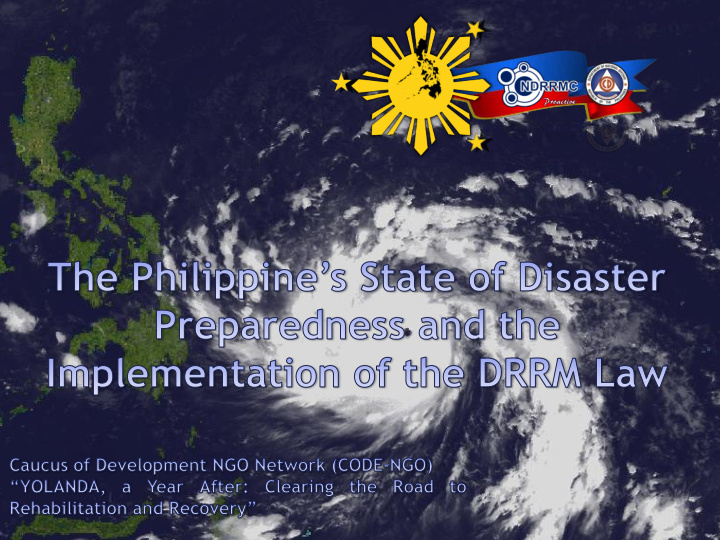



I. Republic Act 10121 II. NDRRM Framework III. NDRRM Plan IV. Accomplishments for Thematic Area V. Results of On-going Consultation re RA10121 Summit/ IRR Review VI. Policy and Institutional Recommendation
“ An Act Strenghthening the Philippine DRRM System, Providing for the National DRRM Framework and Institutionalizing the National DRRM Plan, Appropriating Funds Therefor and for Other Purposes ” Top-down and Bottom-up and participatory centralized disaster disaster risk reduction management Disasters as merely a Disaster mainly a reflection function of physical of people's vulnerability hazards Focus on disaster Integrated approach to genuine response and social and human development to reduce disaster risk anticipation
• Non-state actors aimed neither to generate profits nor to seek governing power • Unite people to advance shared goals and interests • Have a presence in public life, expressing interests and values of their members or others, and are based on ethical, cultural, scientific, religious or philanthropic considerations
PROGRESS OF IMPLEMENTATION • May 27, 2010 – PDRRM Act was signed into law • September 27, 2010 - Implementing Rules and Regulation was signed by the Chairperson, NDRRMC and took effect 15 days after • June 16, 2011 - The National Disaster Risk Reduction and Management Framework (NDRRMF) was signed by the C, NDRRMC, its 4 VCs, ES and A, OCD • October 2011 - Presentation and approval of the National DRRM Plan (2011-2028)
NDRRMC ORGANIZATIONAL STRUCTURE Chairperson Secretary of National Defense Vice Vice Chairperson Vice Chairperson Vice Chairperson Chairperson Sec. DILG Sec. DSWD Sec. NEDA Sec. DOST Disaster Disaster Response Disaster Rehab & Disaster Prev. & Preparedness Recovery Mitigation 4 Leagues & 2 Gov’t 1 Quasi- Gov’t 11 Other Gov’t 14 Line 1 Union of Financial Agency Agencies Departments LGUs Inst. 1 Private 4 Civil Society OCD, Administrator Org. Orgs. Exec. Dir. NDRRMC
National Disaster Risk Reduction and Management Council 17 Regional Disaster Risk Reduction and Management Councils 81 Provincial Disaster Risk Reduction and Management Councils 122 City Disaster Risk Reduction and Management Councils 1, 512 Municipal Disaster Risk Reduction and Management Councils 42,026 Barangay Disaster Risk Reduction and Management Committees
Safer, adaptive and resilient Filipino communities toward sustainable development RISK FACTORS Mainstreaming Hazards DRR and CCA Exposures in Vulnerabilities Planning and Capacities Implementation Prevention & Mitigation Preparedness Rehabilitation & Recovery Response
The National Disaster Risk Reduction and Management Plan emphasizes 4 Thematic Areas with 4 Long-Term Goals which follows the NDRRM Framework
Preparedness Section DISASTER RISK REDUCTION NETWORK PHILIPPINES (DRRNet) • Disaster Information for Nationwide Awareness (DINA ) Project • The NDRRMC mobile applications software “BATINGAW” • The OCD InfoBoard SMS Blasting Solution • Institutionalization of Pre-Disaster Risk Assessment(PDRA )
CENTER FOR DISASTER PREPAREDNESS (CDP) • Module development of NDRRMTI (National Disaster Risk Reduction Management Training Institute) for Local Chief Executives and Barangay Development Council with Local Government Academy • Module development of NDRRMRTI for Communities together with Office of Civil Defense and Japan International Cooperation Agency (OCD & JICA) • Suggested integrating in standard modules an exercise of Local Government Officials that will package all public awareness programs of different agencies
Disaster Prevention/Mitigation Section • Use of risk maps in Community Based Disaster Risk Management (CBDRM) Activities • NDRRMC JMC No. 2013-1 dated 25 March 2013 : Allocation and utilization of the Local Disaster Risk Reduction and Management Fund (LDRRMF) • DOST Project NOAH (National Operational Assessment of Hazard) 06 July 2012 • PHIVOLCS Rapid Earthquake Damage Assessment Software (REDAS) training co-shared with GMMA Ready • DPWH conducted Institutional Capacity Development for DPWH Staff on Disaster Risk Management • DENR/MGB Provided around 8,500 geohazard maps and advisories to local government units on communities identified as prone to landslide and flood hazards
Disaster Response Section • World Vision conducted hygiene promotion and provided food item, six (6) liters of water and hygiene kits in Sagbayan, Bohol • Activation of One-Stop-Shop (OSS) during disasters Disaster Recovery and Rehabilitation Section • PDNA for Sendong, Pablo, Yolanda and PCNA Zamboanga Crisis • Early recovery and rehabilitation • Reconstruction of damaged houses and buildings • Resettlements • Provision for livelihood • Restoration and improvement of destroyed facilities
The salient points/ recommendations captured from the outputs, among others, are as follows: • Increase/full personnel of both OCDRCs/LDRRMOs for the management and operationalization of DRRM networks at all levels. • Institutionalization of Community-Based Early Warning System • Reliability of weather forecasts • Acquisition of relevant DRR equipment, • Propose accountability of donations • Rationalized programming and transparency on the utilization of the LDRRM Fund • Strict implementation of Building Code in ensuring safety measures • Extensive community-based trainings • Full implementation of community-based evacuation drills/simulation exercise • Mandatory organization/accreditation and compensation of Search and Rescue Team per LGU • Guidelines on the institutionalization of logistics management • Capacity building on Geographic Information System (GIS) technology • Apolitical structure that can act independently on DRRM • Train/produce CADREs in every region • Hazard pay for DRRM practitioners
• Identification of specific roles and functions of NGAs, unions/leagues, and civil society in DRRM and CCA • Budget appropriation for DRRM and CCA • Dedicated staff for DRRM and CCA. • Centralized DRRM training for NGAs • Coordination mechanisms during a disaster • Data sharing for risk assessment, mapping, and analysis • Knowledge management system • Gender mainstreaming in DRRM and CCA
Visit us @ www.ndrrmc.gov.ph Email: dopcenbackup@gmail.com SMS: +63 (917) 891-6322 +63 (2) 912-2665 +63 (2) 912-5668 Telefax: +63 (2) 911-1406 +63 (2) 911-5061 to 64 Facebook: Ndrrmc Opcen Twitter: @NDRRMC_Opcen
Recommend
More recommend